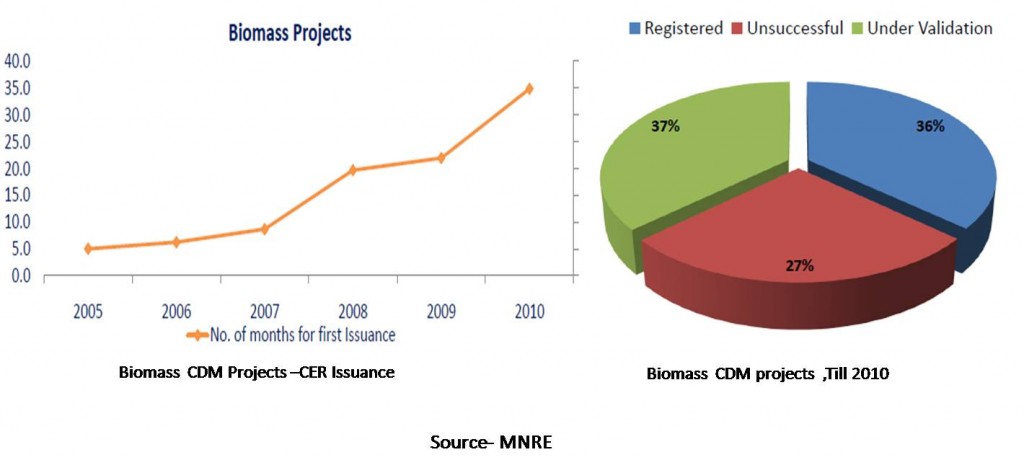Analysis of CDM projects in Indian agriculture sector
Agriculture is one of the biggest contributors to our GDP and can easily take advantage of the Clean Development Mechanism (CDM) under the Kyoto Protocol to earn carbon credits and generate an additional revenue source. This market based mechanism allows developed countries to meet their emission targets by implementing projects in territory of other under-developed countries. The carbon credits generated as a result of these projects can be traded in the market. (Know more about CDM)
Agriculture is one of the high priority sectors but very few projects have been registered so far. One of the main reasons for this is that agriculture in India is highly unorganized and many a times it is difficult to provide evidences under the CDM.
For example, A CDM Agriculture project to offset Nitrogen fertilizers by use of Rhizobium inoculants can be undertaken only if the farmer supplies sufficient evidence in the form of field test reports that the land under consideration was deficient in nitrogen before the start of the project activity. However, very few farmers go for soil testing before undertaking cultivation and such records are not diligently maintained.
By Sep 2011, only 147 CDM projects are registered worldwide under the Agriculture category. Following table shows Indian registered CDM projects;
|
Project Tile |
Annual CERs (Emission Reductions) |
Date of registration |
| 3 MW Poultry Litter Based Power Generation Project, Hyderabad | 65794 | 30 Jun 06 |
| SIDPL Methane extraction and Power generation project | 31966 | 03 Sep 06 |
| “Methane Avoidance by Municipal Solid Waste Processing in the city of Chandigarh, India” | 40308 | 04 Sep 06 |
| Avoidance of Wastewater and On-site Energy Use Emissions and Renewable Energy Generation in IFB Agro Distillery unit | 70760 | 08 Sep 06 |
| Methane recovery and power generation in a distillery plant | 44729 | 29 Sep 06 |
| Methane recovery from waste water generated from wheat straw wash at Paper manufacturing unit of Shreyans Industries Limited (SIL) | 12578 | 02 Apr 07 |
| SESL 6 MW Municipal Solid Waste Based Power Project at Vijayawada & Guntur, Andhra Pradesh | 64599 | 15 Apr 07 |
| Methane Capture and use as fuel at Rajaram Maize Products, Chattisgarh | 4609 | 05 Jun 07 |
| “Forced Methane extraction from Organic wastewater”, at Mandya District, Karnataka by M/s Sri Chamundeswari Sugars Ltd. | 34424 | 27 Jul 07 |
| 3.76 MW Electricity Generation project from Poultry Litter in Tamil Nadu | 55858 | 04 Mar 09 |
(Read more on CDM project statistics)
One of the areas in which CDM agriculture projects can be initiated is the biomass projects. The agriculture residue of crops (There are five categories of biomass – Agriculture residues, Virgin wood, Energy crops, Food wastes, Industrial wastes) which cannot be used as cattle feed and are simply burnt can be used for such biomass projects to generate electricity. Such a project would offset the green house gas production as the residue instead of being burnt would be used to produce electricity. This results in dual benefits. One, it generates electricity which can be used to run farm machinery and two, it earns carbon credits as a CDM project further earning revenues.

As per the estimate by MNRE, power potential from surplus agro residues in the country is about 17,000 MW. In addition about 5000 MW of power can be produced, if the sugar mills in the country switch over to modern techniques of cogeneration.
Preliminary techno-commercial parameters of the biomass power projects;
| Parameters | Bagasse based co-generation project | Biomass based power generation project |
| Capital cost of installation | Rs. 4.5 to Rs. 5.0 Crore/MW depending upon technical, financial and operating parameters | Rs.4.5 to 5.0 Crore/MW depending upon boiler pressure and capacity |
| Costs of generation | Rs. 3.25 to 3.75/kwh | Rs. 3.50 to Rs. 4.00/kwh |
| Plant load factor | 45% – 55% | 70% – 75% |
The governments of Punjab and Haryana are providing subsidies to farmers for establishing biomass projects. Both the states are looking towards such projects to meet their (agriculture) electricity requirements. The government subsidy and income from carbon credits would make such a biomass project economically attractive.
In case the size of the farm is small and the residue generated is not enough to feed the biomass project, then CDM provides the option to bundle up several such small projects and seek carbon credits collectively.
Thus, Agriculture CDM projects offer a lucrative option for the farmers to reap revenues from carbon credits and also provide an environmentally friendly option in dealing with their agriculture residues.
Information Source: UNFCCC-CDM, MNRE
Authors: Puskar Pande, Shailesh Telang
Know more on How Municipal Solid Waste Disposal Sites Emit Methane?

